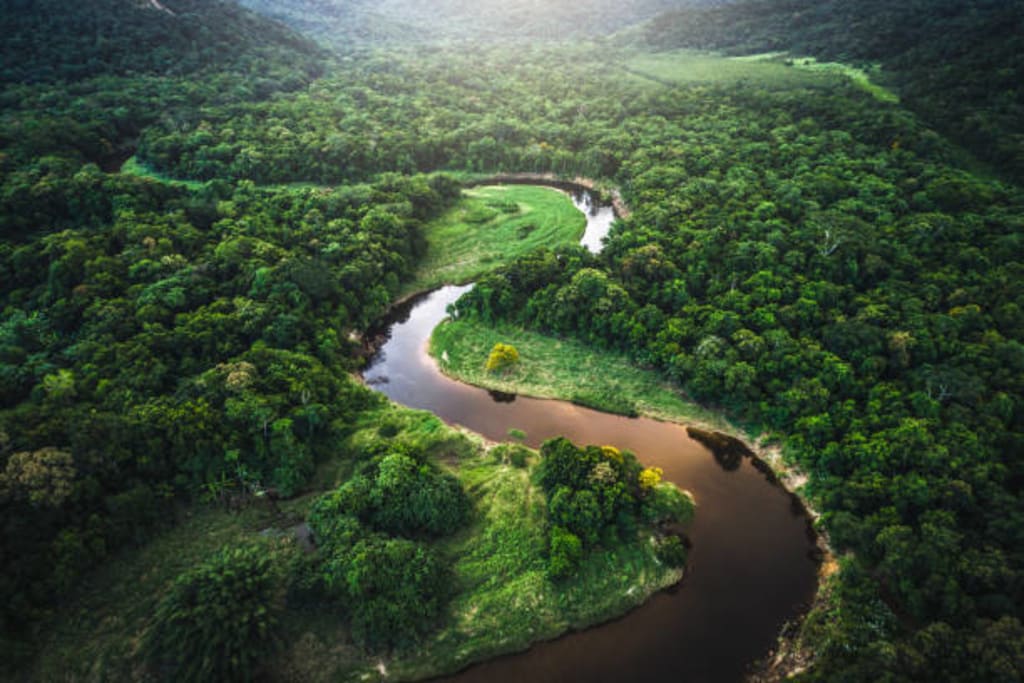The greatest river of South America (Amazon)
Amazon River:

• The Amazon River is the largest river in the world by volume, with a total discharge greater than the next seven largest rivers combined.
• The river is located in South America and runs through Brazil, Colombia, and Peru, among other countries.
• The Amazon River and its tributaries flow for over 6,400 km (4,000 miles) from the Andes Mountains in Peru to the Atlantic Ocean in Brazil.
• The river basin covers an area of about 7 million square kilometers (2.7 million square miles) and is home to the world's largest rainforest, the Amazon Rainforest.
• The Amazon Rainforest is home to an estimated 10% of the world's species and is one of the most biodiverse regions on the planet.
• The Amazon River and its tributaries support the livelihoods of millions of people living in the region through fishing, agriculture, and transportation.
• The river is also an important transportation route for goods and people, with many small communities accessible only by boat.
• The Amazon River is facing significant threats from deforestation, mining, and climate change, which are leading to the destruction of habitats and loss of biodiversity in the region.
Certainly! Here is some more information about the geography, history, and cultural significance of the Amazon River:
Geography:
• The Amazon River basin covers an area of about 7 million square kilometers (2.7 million square miles) and is home to the world's largest rainforest, the Amazon Rainforest.
• The river originates in the Andes Mountains in Peru and flows eastward for over 6,400 km (4,000 miles) before emptying into the Atlantic Ocean in Brazil.
• The Amazon River is the largest river in the world by volume, with a total discharge greater than the next seven largest rivers combined.
• The river and its tributaries are home to many unique and diverse species of plants and animals, including some that are found nowhere else on Earth.
History:
• The history of the Amazon River region dates back thousands of years, with evidence of human habitation as far back as 13,000 years ago.
• The indigenous peoples of the Amazon River region developed complex societies and cultures, including the Inca Empire, which ruled parts of the region until the arrival of Europeans in the 16th century.
• The first European to explore the Amazon River was Spanish explorer Francisco de Orellana, who navigated the river from its source in the Andes to the Atlantic Ocean in 1542.
• The Amazon River region became an important center of the European colonial economy, with vast quantities of natural resources, including rubber, timber, and gold, being exported to Europe.
• The exploitation of these resources had a devastating impact on the region's indigenous populations and the natural environment.
Cultural Significance:
• The Amazon River and its tributaries have played a central role in the cultures and traditions of the indigenous peoples of the region for thousands of years.
• The river is seen as a source of life and a sacred place, with many indigenous groups performing rituals and ceremonies to honor it.
• The region's biodiversity and traditional knowledge of the local communities have also led to the development of traditional medicine, food, and other products that have been used by people around the world.
• The Amazon River and the rainforest it flows through have also become important symbols of the global environmental movement, with many organizations working to protect the region's unique ecology and the communities that depend on it.
Certainly! The Amazon River and its surrounding rainforest face a number of challenges, including:
1. Deforestation: The Amazon Rainforest is being destroyed at an alarming rate, with an estimated 17% of the forest having been lost over the past 50 years. Deforestation is driven by a range of factors, including logging, mining, agriculture, and urbanization.
2. Climate Change: The Amazon Rainforest is an important carbon sink, helping to regulate global climate patterns. However, climate change is causing the region to experience more frequent and severe droughts, which can lead to forest fires and the loss of plant and animal species.
3. Mining: Mining activities in the region are causing significant environmental damage, including the contamination of rivers and other water sources with heavy metals.
4. Agriculture: The expansion of agriculture, particularly cattle ranching and soybean farming, is a major driver of deforestation in the region.
5. Infrastructure Projects: Large-scale infrastructure projects, such as hydroelectric dams and highways, are also contributing to the destruction of the Amazon Rainforest and the displacement of indigenous communities.
Efforts to protect the Amazon River and its surrounding rainforest are being undertaken by a range of organizations and governments, both in the region and around the world. Some of the key initiatives include:
1. Protected Areas: The creation of protected areas, such as national parks and nature reserves, is one of the most effective ways to conserve the biodiversity of the Amazon Rainforest.
2. Sustainable Development: Efforts to promote sustainable development in the region, including ecotourism and community-based conservation, can help to reduce the pressure on natural resources and support the livelihoods of local communities.
3. Forest Restoration: Reforestation and forest restoration programs can help to mitigate the impact of deforestation and restore degraded ecosystems.
4. Indigenous Rights: Recognizing and protecting the rights of indigenous peoples, who are often the most effective stewards of the region's natural resources, is essential to the long-term conservation of the Amazon River and the surrounding rain forest.
5. International Cooperation: Collaboration between governments, organizations, and communities across borders and sectors is necessary to address the complex challenges facing the Amazon River and its surrounding rain forest.
About the Creator
Enjoyed the story? Support the Creator.
Subscribe for free to receive all their stories in your feed. You could also pledge your support or give them a one-off tip, letting them know you appreciate their work.






Comments
There are no comments for this story
Be the first to respond and start the conversation.